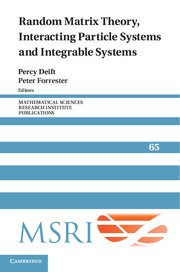Book contents
- Frontmatter
- Contents
- Preface
- Universality conjecture for all Airy, sine and Bessel kernels in the complex plane
- On a relationship between high rank cases and rank one cases of Hermitian random matrix models with external
- Riemann–Hilbert approach to the six-vertex model
- CLT for spectra of submatrices of Wigner random matrices, II: Stochastic evolution
- Critical asymptotic behavior for the Korteweg–de Vries equation and in random matrix theory
- On the asymptotics of a Toeplitz determinant with singularities
- Asymptotic analysis of the two-matrix model with a quartic potential
- Conservation laws of random matrix theory
- Asymptotics of spacing distributions 50 years later
- Applications of random matrix theory for sensor array imaging with measurement noise
- Convolution symmetries of integrable hierarchies, matrix models and τ-functions
- Universality limits via “old style” analysis
- Fluctuations and large deviations of some perturbed random matrices
- Three lectures on free probability
- Whittaker functions and relatedstochastic processes
- How long does it take to compute the eigenvalues of a random symmetric matrix?
- Exact solutions of the Kardar–Parisi–Zhang equation and weak universality for directed random polymers
- Replica analysis of the one-dimensional KPZ equation
- Asymptotic expansions for β matrix models and their applications to the universality conjecture
- KPZ scaling theory and the semidiscrete directed polymer model
- Experimental Realization Of Tracy–Widom Distributions And Beyond: Kpz Interfaces In Turbulent Liquid Crystal
- Random matrices: the four-moment theorem for Wigner ensembles
CLT for spectra of submatrices of Wigner random matrices, II: Stochastic evolution
Published online by Cambridge University Press: 29 May 2025
- Frontmatter
- Contents
- Preface
- Universality conjecture for all Airy, sine and Bessel kernels in the complex plane
- On a relationship between high rank cases and rank one cases of Hermitian random matrix models with external
- Riemann–Hilbert approach to the six-vertex model
- CLT for spectra of submatrices of Wigner random matrices, II: Stochastic evolution
- Critical asymptotic behavior for the Korteweg–de Vries equation and in random matrix theory
- On the asymptotics of a Toeplitz determinant with singularities
- Asymptotic analysis of the two-matrix model with a quartic potential
- Conservation laws of random matrix theory
- Asymptotics of spacing distributions 50 years later
- Applications of random matrix theory for sensor array imaging with measurement noise
- Convolution symmetries of integrable hierarchies, matrix models and τ-functions
- Universality limits via “old style” analysis
- Fluctuations and large deviations of some perturbed random matrices
- Three lectures on free probability
- Whittaker functions and relatedstochastic processes
- How long does it take to compute the eigenvalues of a random symmetric matrix?
- Exact solutions of the Kardar–Parisi–Zhang equation and weak universality for directed random polymers
- Replica analysis of the one-dimensional KPZ equation
- Asymptotic expansions for β matrix models and their applications to the universality conjecture
- KPZ scaling theory and the semidiscrete directed polymer model
- Experimental Realization Of Tracy–Widom Distributions And Beyond: Kpz Interfaces In Turbulent Liquid Crystal
- Random matrices: the four-moment theorem for Wigner ensembles
Summary
We show that the global fluctuations of spectra of GOE and GUE matrices and their principal submatrices executing Dyson's Brownian motion are Gaussian in the limit of large matrix dimensions. For nested submatrices one obtains a limiting three-dimensional generalized Gaussian process; its restrictions to two-dimensional sections that are monotone in matrix sizes and time moments coincide with the two-dimensional Gaussian free field with zero boundary conditions. The proof is by moment convergence, and it extends to more general Wigner matrices and their stochastic evolution.
Introduction. The fact that the global spectral fluctuations of a GOE or a GUE random matrix evolving under Dyson's Brownian motion, are asymptotically Gaussian is well-known; see [Anderson et al. 2010, Section 4.3.3] and references therein, and also [Spohn 1998] for a generalβ analog. On the other hand, it was shown in [Borodin 2014] that the global fluctuations of spectra of various principal submatrices of a single GOE or GUE matrix are also Gaussian. The goal of this article is to put these two statements together.
We prove the asymptotic Gaussian behavior for submatrices of a class of stochastically evolving Wigner random matrices that includes Dyson's Brownian motion for GOE and GUE. The proof is by the method of moments, and the argument is slightly more general than the one presented in [Anderson et al. 2010] for a single Wigner matrix. We also compute the resulting covariance kernel explicitly. In the case of nesting submatrices, it represents a three-dimensional generalized Gaussian process, where one dimension comes from the position of the spectral variable, the second dimension reflects the size of the submatrix, and the third dimension is the time variable. When restricted to the two-dimensional sections that are monotone in matrix size and time variables, it reproduces the two-dimensional Gaussian free field (GFF) with zero boundary conditions.
In the case of GUE, the appearance of GFF on monotone sections could have been predicted from the determinantal structure of the correlation functions
[Ferrari and Frings 2010; Adler et al. 2010b], and from the analysis of [Borodin and Ferrari 2014] that showed how such a structure leads to GFF covariances in the global asymptotic regime. However, the complete three-dimensional covariance structure seems to be inaccessible via that approach for example because the spectra of the full set of submatrices evolve in a non-Markovian way [Adler et al. 2010a].
Information
- Type
- Chapter
- Information
- Publisher: Cambridge University PressPrint publication year: 2014
Accessibility standard: Unknown
Why this information is here
This section outlines the accessibility features of this content - including support for screen readers, full keyboard navigation and high-contrast display options. This may not be relevant for you.Accessibility Information
- 3
- Cited by
